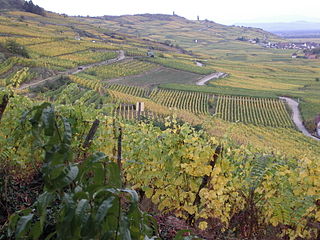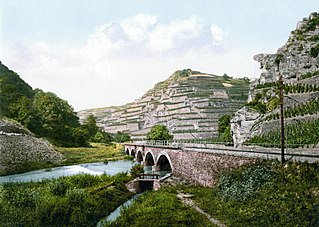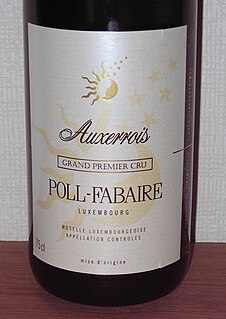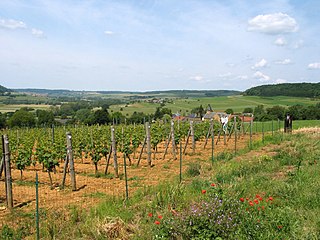
Beaujolais is a French Appellation d'Origine Contrôlée (AOC) wine generally made of the Gamay grape, which has a thin skin and is low in tannins. Like most AOC wines they are not labeled varietally. Whites from the region, which make up only 1% of its production, are made mostly with Chardonnay grapes though Aligoté is also permitted until 2024. Beaujolais tends to be a very light-bodied red wine, with relatively high amounts of acidity. In some vintages, Beaujolais produces more wine than the Burgundy wine regions of Chablis, Côte d'Or, Côte Chalonnaise and Mâconnais put together.

Burgundy wine is made in the Burgundy region of eastern France, in the valleys and slopes west of the Saône, a tributary of the Rhône. The most famous wines produced here—those commonly referred to as "Burgundies"—are dry red wines made from pinot noir grapes and white wines made from chardonnay grapes.
A winemaker or vintner is a person engaged in winemaking. They are generally employed by wineries or wine companies, where their work includes:

German wine is primarily produced in the west of Germany, along the river Rhine and its tributaries, with the oldest plantations going back to the Roman era. Approximately 60 percent of German wine is produced in the state of Rhineland-Palatinate, where 6 of the 13 regions (Anbaugebiete) for quality wine are situated. Germany has about 103,000 hectares of vineyard, which is around one tenth of the vineyard surface in Spain, France or Italy. The total wine production is usually around 10 million hectoliters annually, corresponding to 1.3 billion bottles, which places Germany as the eighth-largest wine-producing country in the world. White wine accounts for almost two thirds of the total production.

Alsace wine or Alsatian wine is produced in the Alsace region in France and is primarily white wine. Because of its Germanic influence, it is the only Appellation d'Origine Contrôlée region in France to produce mostly varietal wines, typically from similar grape varieties to those used in German wine. Along with Austria and Germany, it produces some of the most noted dry Rieslings in the world as well as highly aromatic Gewürztraminer wines. Wines are produced under three different AOCs: Alsace AOC for white, rosé and red wines, Alsace Grand Cru AOC for white wines from certain classified vineyards and Crémant d'Alsace AOC for sparkling wines. Both dry and sweet white wines are produced.

Muscadet is a French white wine. It is made at the western end of the Loire Valley, near the city of Nantes in the Pays de la Loire region. It is made from the Melon de Bourgogne grape, often referred to simply as melon. While most appellation d'origine contrôlée wines are named after their growing region, or in Alsace after their variety, the name Muscadet refers to an alleged characteristic of the wine produced by the melon grape variety: vin qui a un goût musqué. However, according to wine expert Tom Stevenson, Muscadet wines do not have much, if any, muskiness or Muscat-like flavors or aromas.

Bordeaux wine is produced in the Bordeaux region of southwest France, around the city of Bordeaux, on the Garonne River. To the north of the city the Dordogne River joins the Garonne forming the broad estuary called the Gironde; the Gironde department, with a total vineyard area of over 120,000 hectares, is the largest wine growing area in France.

French wine is produced all throughout France, in quantities between 50 and 60 million hectolitres per year, or 7–8 billion bottles. France is one of the largest wine producers in the world, along with Italian, Spanish, and American wine-producing regions. French wine traces its history to the 6th century BC, with many of France's regions dating their wine-making history to Roman times. The wines produced range from expensive wines sold internationally to modest wines usually only seen within France such as the Margnat wines were during the post war period.
South African wine has a history dating back to 1659, with the first bottle produced in Cape Town by its founder Jan van Riebeeck. Access to international markets led to new investment in the South African wine market. Production is concentrated around Cape Town, with major vineyard and production centres at Constantia, Paarl, Stellenbosch and Worcester. There are about 60 appellations within the Wine of Origin (WO) system, which was implemented in 1973 with a hierarchy of designated production regions, districts and wards. WO wines must only contain grapes from the specific area of origin. "Single vineyard" wines must come from a defined area of less than 6 hectares. An "Estate Wine" can come from adjacent farms if they are farmed together and wine is produced on site. A ward is an area with a distinctive soil type or climate and is roughly equivalent to a European appellation.
The glossary of wine terms lists the definitions of many general terms used within the wine industry. For terms specific to viticulture, winemaking, grape varieties, and wine tasting, see the topic specific list in the "See also" section below.
Côtes de Toul is an Appellation d'Origine Contrôlée (AOC) for French wine produced in the département of Meurthe-et-Moselle in the Lorraine région. The Côtes de Toul vineyards cover 110 hectares in an area close to Toul, to the west of the city of Nancy. The area of production includes the following communes: Blénod-lès-Toul, Bruley, Bulligny, Charmes-la-Côte, Domgermain, Lucey, Mont-le-Vignoble and Pagney-derrière-Barine. Annual production is 4,500 hectoliter, corresponding to 600,000 bottles.

Swiss wine is produced from nearly 15,000 hectares of vineyards, and the wines are mainly produced in the west and in the south of Switzerland, in the cantons of Geneva, Neuchâtel, Ticino, Valais and Vaud. White grape varieties are grown on 43% of the country's vineyard area, and red grape varieties on 57%.

Moselle wine is produced in three countries along the Moselle river: France, Luxembourg and Germany. Moselle wines are mainly white and are made in some of the coldest climates used for commercial winemaking.

Algerian wine is wine made in Algeria. While not a significant force on the world's wine market today, Algeria has played an important role in the history of wine. Algeria's viticultural history dates back to its settlement by the Phoenicians and continued under Algeria's rule by the Roman empire. Just prior to the Algerian War of Independence (1954-1962), Algerian wine accounted for nearly two-thirds of the total international wine trade. With as much land under vine as the countries of Germany and South Africa, Algeria continues to maintain a wine industry with over 70 wineries in operation.

Baden is a region (Anbaugebiet) for quality wine in Germany, and is located in the historical region of Baden in southwestern Germany, which today forms part of the federal state of Baden-Württemberg. Under German wine legislation, Baden and Württemberg are separate wine regions.

Ahr is a wine region (Anbaugebiet) for quality wine in Germany, and is located in the valley of the river Ahr, a tributary of Rhine, and is situated in the federal state of Rhineland-Palatinate. With only 558 hectares of vines as of 2008, it is one of smaller of Germany's 13 regions. Despite its northern location it primarily produces red wines, and red grape varieties account for 86% of the vineyard area, which is more than in any other German wine region.
European Union wine growing zones are used in the common European Union wine regulations to regulate certain aspects of winemaking. The zones differ in terms of climate and examples of what is regulated by wine growing zone are required grape maturity at harvest and allowed levels of chaptalisation. There are 21 wine producing countries in the European Union, with 14 of them having significant levels of production. In the 2004-2005 vintage, total European Union wine production was around 184 million hectoliters which accounted for nearly 70% of total worldwide production. Of that total, nearly 55% was classified as table wine with 4% used in the production of grape-based distilled spirits such as Armagnac and Cognac.

Luxembourg wine is primarily produced in the southeastern part of the Grand Duchy of Luxembourg, with vineyards overlooking the Moselle River. Along this river, which for 42 km makes up part of the border between Luxembourg and Germany, wine is made in three countries. There is a continuous history of winemaking along Moselle and in Luxembourg going back to Ancient Roman times. Wine production in 2006/07 was 123,652 hectoliter from 1,237 hectares of vineyards. Out of total wine exports of 87,776 hectoliter in 2005/06, 71,726 hectoliter or 82% was exported to nearby Belgium. Exports to Germany were the second largest at 8,168 hectoliter, or 9%, and is to a large extent made up of base wine in bulk for the production of blended Sekt rather than being sold bottled with "Luxembourg" anywhere on the label. Therefore, very little Luxembourg wine is seen outside Luxembourg and Belgium.

Belgian wine is produced in several parts of Belgium and production, although still modest at 1,400 hectoliters in 2004, has expanded in recent decades.

Hugel & Fils is a winery in Riquewihr, Alsace, France. Hugel & Fils is one of the major producers of Alsace wine, and has been an important force in the Alsace wine industry in its developments during the second half of the 20th century.
















